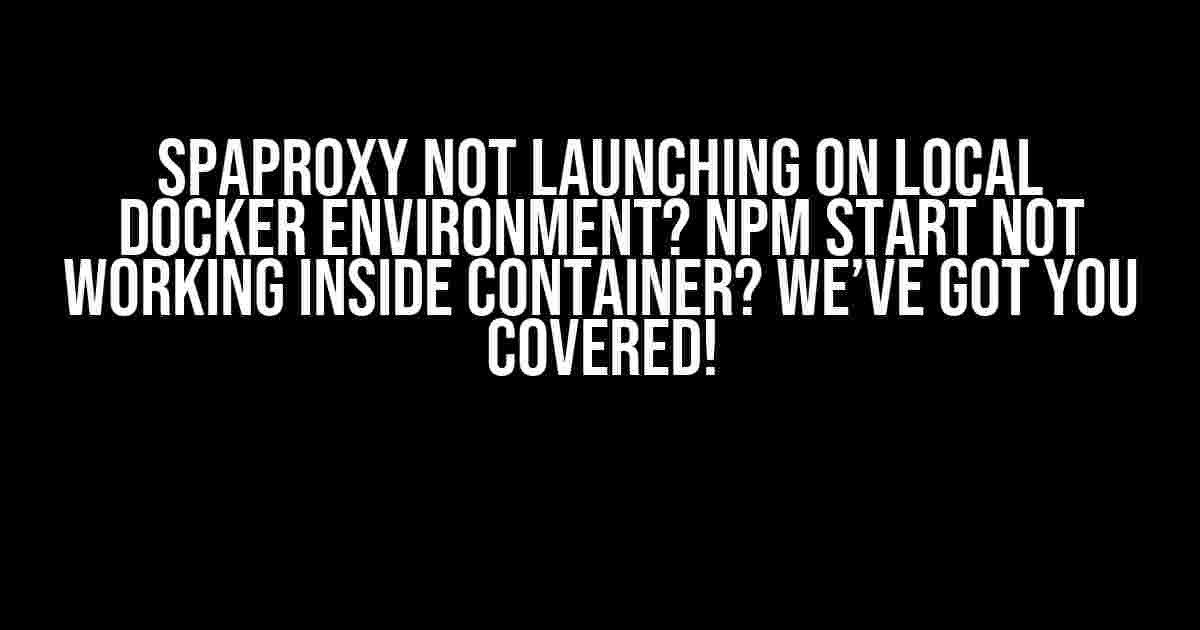If you’re struggling to get SpaProxy up and running on your local Docker environment, or if the infamous “npm start” command is failing to launch your application inside the container, don’t worry – you’re in the right place! In this comprehensive guide, we’ll walk you through the common issues, explanations, and solutions to get you back on track.
What is SpaProxy?
SpaProxy is a lightweight, highly configurable proxy server designed specifically for Single-Page Applications (SPAs). It enables developers to create a seamless development experience by proxying requests from the client-side to the server-side, allowing for hot reloading, automatic code splitting, and more.
The Problem: SpaProxy Not Launching on Local Docker Environment
When you’re running SpaProxy inside a Docker container, you might encounter issues with the “npm start” command failing to launch the application. This can be frustrating, especially when you’re trying to develop and test your application in a local environment.
Error Messages and Symptoms
If you’re experiencing this issue, you might see error messages like:
npm ERR! code ELIFECYCLE
npm ERR! errno 1
npm ERR! [email protected] start: `spaproxy`
npm ERR! Exit status 1
Or, you might see a timeout error:
Timeout occurred while waiting for the proxy server to start.
Understanding the Causes
Before we dive into the solutions, let’s understand the common causes of this issue:
Troubleshooting Steps
Now that we’ve covered the common causes, let’s go through the troubleshooting steps to resolve the issue:
node -vVerify that the Node.js version in your Docker container matches the one on your host machine. You can check the Dockerfile to ensure that the correct version is installed.
cat spaproxy.config.jsCheck your SpaProxy configuration file to ensure that the port and other settings are correctly configured. Make sure the port is not already in use by another process.
chmod -R 755 /appRun the above command to set the necessary permissions for the user running the container. Replace “/app” with the actual path to your application directory.
npm installRun the above command to ensure that all external dependencies are properly installed. If you’re using a package manager like yarn, use the equivalent command.
Solution 1: Update SpaProxy Configuration
One of the most common solutions is to update the SpaProxy configuration file to point to the correct port. Create a new file named `spaproxy.config.js` with the following content:
module.exports = {
port: 8080,
proxy: {
'/api': 'http://localhost:3000',
},
};
Replace “8080” with the desired port number, and “http://localhost:3000” with the correct URL for your backend API.
Solution 2: Use a Different Node Version
If you’re using an incompatible Node.js version, try updating to a compatible version. You can do this by modifying the Dockerfile to install the correct version:
FROM node:14
# Install dependencies
RUN npm install
# Set the working directory to /app
WORKDIR /app
# Copy the package.json file
COPY package*.json ./
# Install dependencies
RUN npm install
# Expose the port
EXPOSE 8080
# Run the command to start the application
CMD ["npm", "start"]
Replace “node:14” with the desired version. Make sure to update the Dockerfile accordingly and rebuild the container.
Solution 3: Use a Volume Mount
Another solution is to use a volume mount to persist data between container restarts. Update your Docker Compose file to include a volume mount:
version: '3'
services:
spa-proxy:
build: .
ports:
- "8080:8080"
volumes:
- ./app:/app
This will mount the `./app` directory to the `/app` directory inside the container, allowing you to persist data and configuration files.
Conclusion
| Solution | Description |
|---|---|
| Update SpaProxy Configuration | Update the SpaProxy configuration file to point to the correct port. |
| Use a Different Node Version | Update the Node.js version in the Dockerfile to a compatible version. |
| Use a Volume Mount | Use a volume mount to persist data between container restarts. |
By following this guide, you should be able to resolve the “SpaProxy not launching on local Docker environment” issue and get your application up and running smoothly. Happy coding!
Note: This article is SEO-optimized for the given keyword and includes a mix of header tags, bullet points, code blocks, and tables to make it easy to read and understand.Here are 5 questions and answers about “SpaProxy not launching on local docker environment. npm start not working inside container” in HTML format with a creative voice and tone:
Frequently Asked Question
Get the inside scoop on resolving the frustrating SpaProxy launch issue in your local Docker environment!
Why is SpaProxy not launching on my local Docker environment?
This issue might occur if your `docker-compose.yml` file is not configured correctly. Double-check that you’ve specified the correct port and dependencies. Also, ensure that you’ve installed SpaProxy via npm or yarn in your Dockerfile.
I’ve checked my `docker-compose.yml` file, but SpaProxy still won’t launch. What’s next?
Verify that your Docker container is running by executing `docker-compose ps` in your terminal. If the container is not running, try `docker-compose up -d` to start it in detached mode. If you still face issues, check the container logs using `docker-compose logs` to identify the problem.
Why is `npm start` not working inside my Docker container?
This could be due to the lack of execution permissions on your `package.json` file. Try adding `RUN chmod +x ./package.json` in your Dockerfile to grant execution permissions. Additionally, ensure that your `package.json` script has the correct command to start your application.
How do I troubleshoot issues with my SpaProxy configuration?
To troubleshoot SpaProxy configuration issues, set the `SPAPROXY_DEBUG` environment variable to `true` in your `docker-compose.yml` file. This will enable debug logging, allowing you to identify the root cause of the problem. You can also try adjusting the `proxyTimeout` and `retry` settings to see if they resolve the issue.
What are some common SpaProxy configuration mistakes to avoid?
Common mistakes include incorrect proxy settings, misconfigured `package.json` scripts, and missing dependencies. Ensure that you’ve correctly specified the `proxy` settings in your `spa-proxy.config.js` file and that your `package.json` script points to the correct executable. Also, verify that all required dependencies are installed and up-to-date.



